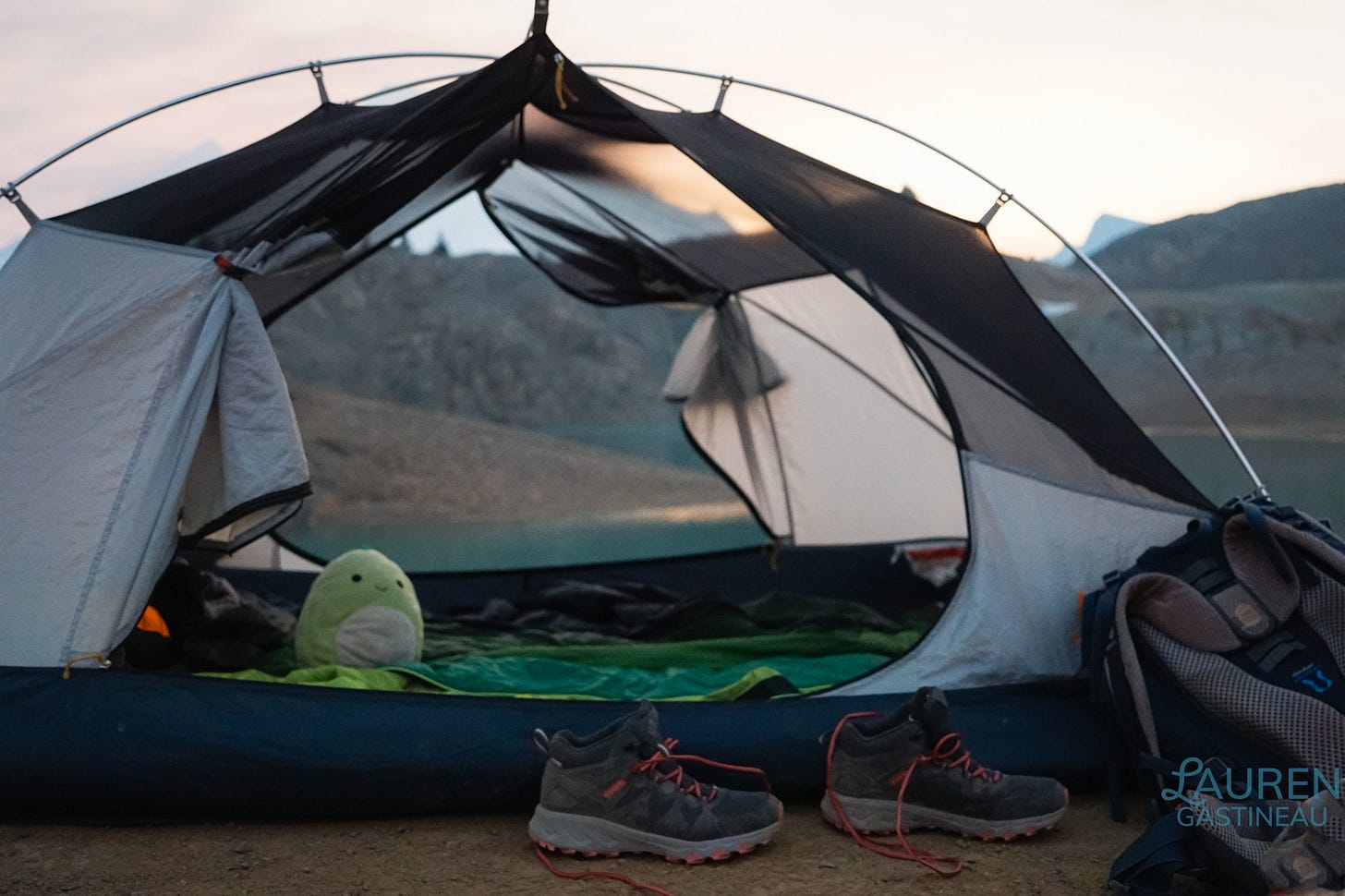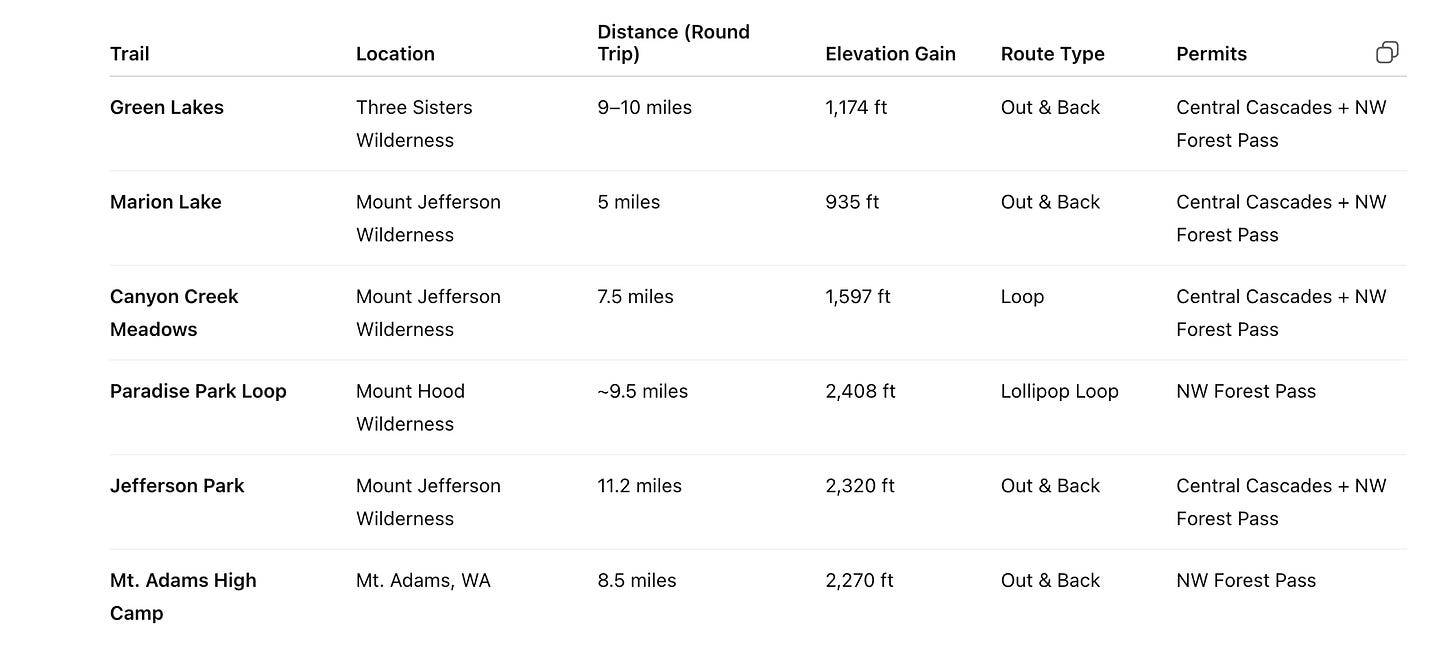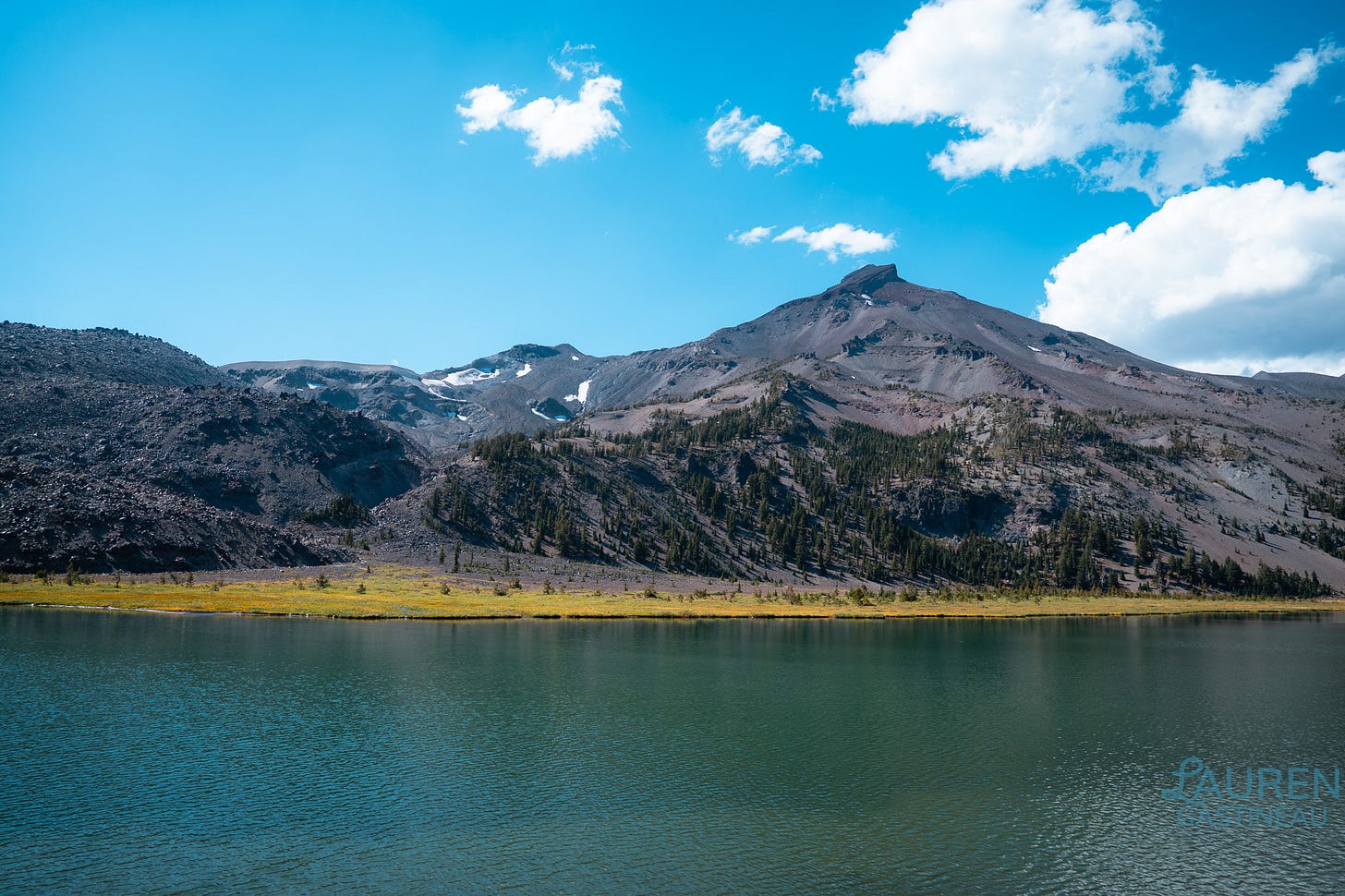New to Backpacking? Start Here.
Best beginner trails near Bend + Portland, packing tips, and what I wish I knew before my first trip
Hey friend, welcome back to the Big Adventure Club ☀️
My marathon weekend has officially passed. While I still feel sad I didn’t get the chance to race my best, I’m also deeply grateful for the choice to listen to my body. I didn’t force it. I protected my long-term health. And even though it stung, it’s a decision I stand by.
Instead of racing, I extended my trip and spent the whole weekend in Seattle. Seven hours of solo road tripping from Bend, camping under the stars, eating so much good food (hi ube lattes), picnicking at Gas Works, joining a run club meetup, and even carving out an afternoon to lay on the beach with a book. It turned into something completely different than I expected, and kind of perfect in its own way.

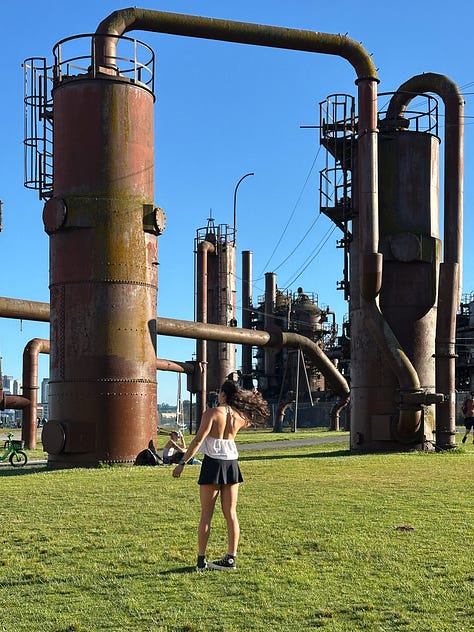
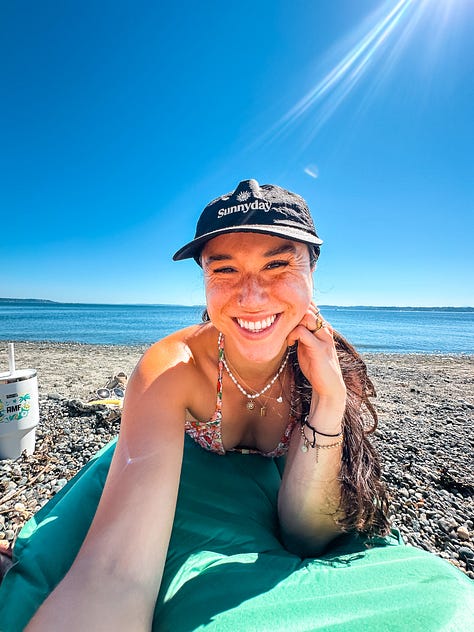
That quiet reset reminded me how much joy there is in the simple things: fresh air, a packed bag, and one night outside. So this week’s newsletter is a guide to beginner-friendly backpacking trips near Bend and Portland. The kind of overnights that helped me fall in love with the outdoors when I was first starting out.
One-Night Backpacking Trips for Beginners
Beginner-friendly backpacking routes near Bend & Portland
You’ve got your gear dialed in. You’ve read the blog posts, saved the Instagram tips, maybe even practiced packing your bear bag. Now comes the hardest part: figuring out where to go.
This week, I’m sharing a few of my favorite beginner-friendly overnight backpacking routes. All within a few hours of Bend or Portland. These trails are short, scenic, and ideal for getting used to carrying weight without biting off more than you can chew.
Whether you’re testing out new gear or just want an easy one-nighter with a big reward, these routes are a great place to start.
PS: I say “beginner,” but don’t underestimate these! Make sure you’re physically ready to hike at least 5–6 miles a day with your full pack. Even better? Do a practice hike beforehand — load up your backpack and see how your body feels over a few miles.
Camping experience and knowing how to “go” outside (yes, with a trowel or wag bag) are big pluses too. Brush up on Leave No Trace, know how to filter water, and double-check trail conditions before you head out.
I’ve learned the hard way that being underprepared can turn a fun trip into a Type 2 kind of weekend real fast. Don’t be like past me. Plan ahead, pack smart, and know your limits.
Quick Stats: Beginner-Friendly Backpacking Trips
Note: Permit season for the Central Cascades typically runs June 15 – October 15.
Want my backpacking packing list? If you’re just getting started, I made a simple, no-BS packing list to help you feel prepared (and not forget the tiny stuff like your trowel or electrolytes).
Green Lakes
Three Sisters Wilderness | Bend, OR
9–10 miles RT | 1,174 ft gain | Out & Back
Central Cascade Permit Required + NW Forest Pass Required
If you’re looking for a first backpacking trip near Bend, it’s hard to beat Green Lakes. This trail winds through pine forest, crosses bubbling creeks, and opens up to an alpine basin dotted with crystal-clear lakes — all framed by views of South Sister and Broken Top.
At around 4.5–5 miles in, you’ll reach the lake and find several dispersed campsites with views of the water and nearby peaks. Campsites are first come, first served and easy to spot, but they can fill up quickly on weekends.
Best time to go: Late August through early October.
Early in the season, the trail can still be snowy and the mosquitoes are relentless. But by late summer, the bugs die down and the days are perfect for hiking and lake dips. Just make sure to pack warm layers — nights can dip below freezing even in September.
Trail tip: Campsites are all marked on GPS tracks and are suprisingly abundant.
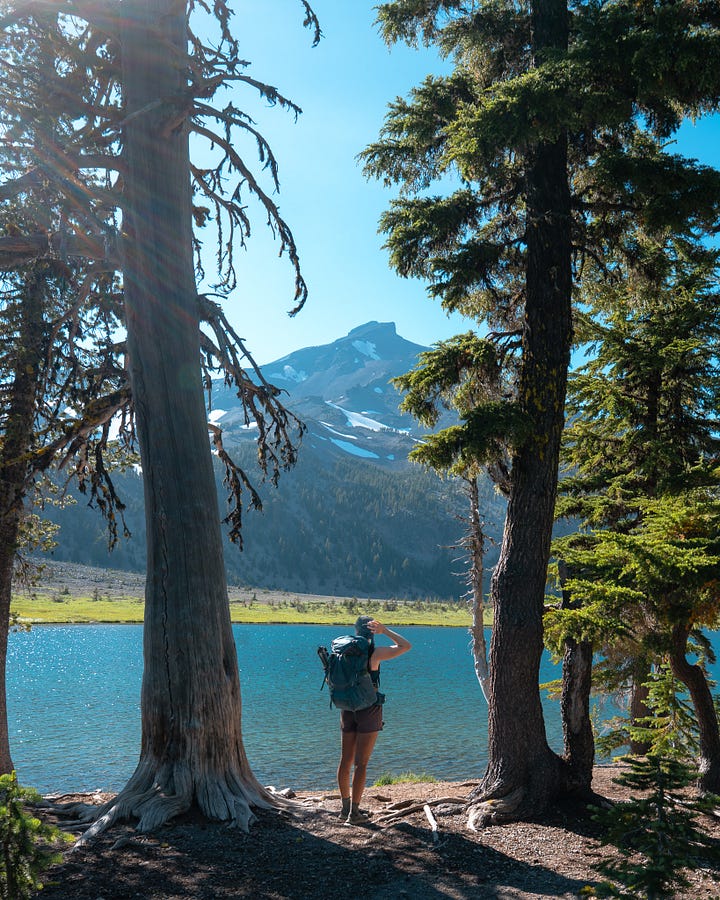

Paradise Park Lollipop Loop
Mount Hood Wilderness | Mount Hood, OR
~9.5 miles RT | 2,408 ft gain | Lollipop Loop
NW Forest Pass Required
If you’re looking for wildflowers, alpine meadows, and wide-open views of Mount Hood, Paradise Park lives up to the name. This loop begins at Timberline Lodge and climbs steadily along the Timberline Trail before veering onto the Paradise Park Trail, where things open up into high-alpine meadows with dreamy campsites near Lost Creek.
The full loop is just under 10 miles. It’s a great “level up” from a true beginner trip: more elevation, but well-traveled and easy to follow.
Best time to go: Late July to mid-September.
Earlier in the season, snow can linger above timberline. By August, wildflowers bloom like crazy and the trail becomes prime overnight material.
Trail tip: Timberline Lodge has restrooms and snacks. A luxury start or end to a backcountry night.

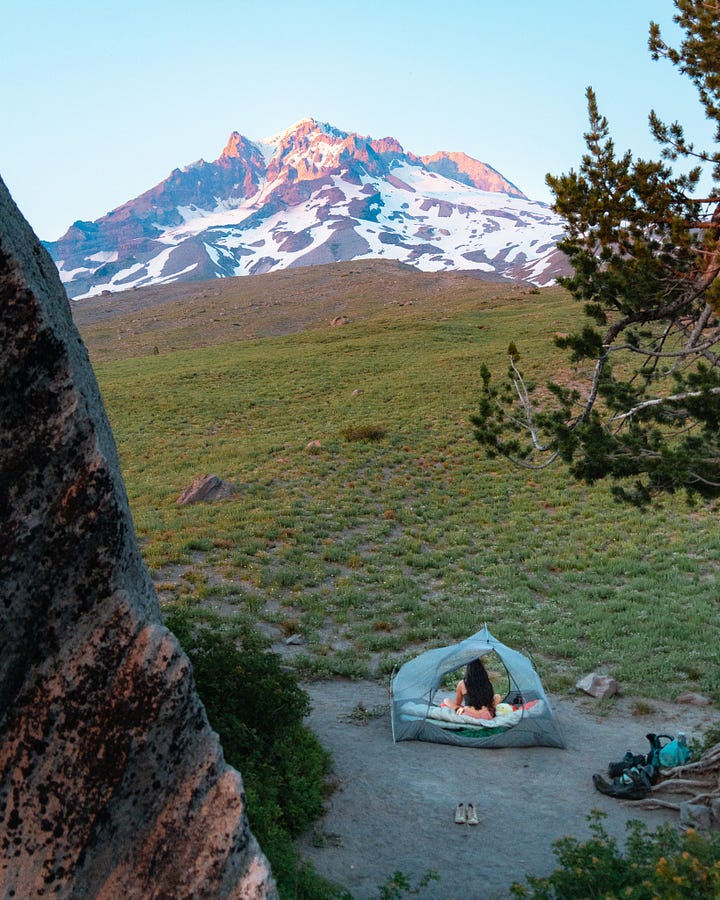
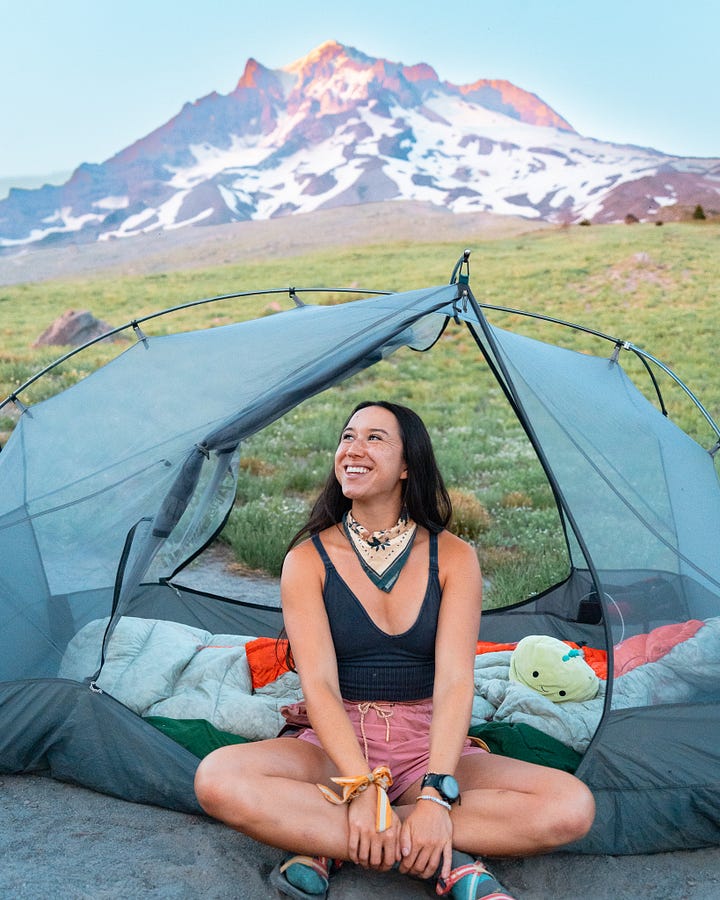
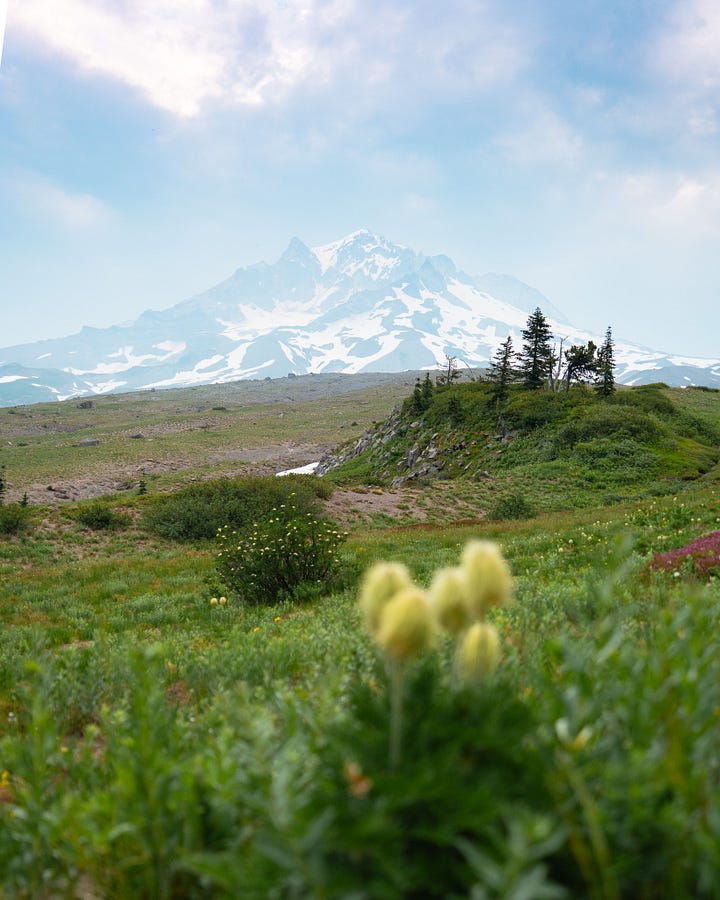
Mt. Adams High Camp
Gifford Pinchot National Forest | Mt. Adams, WA
8.5 miles RT | 2,270 ft gain | Out & Back
NW Forest Pass Required
The route to High Camp climbs from the Killen Creek Trailhead through forest and wildflower meadows until you reach a subalpine basin with jaw-dropping views of Mt. Adams.
The trail is steeper than it looks on paper, but it’s well-defined and absolutely stunning. There are established primitive campsites near the top, and if you go late in the season, you’ll likely have the place to yourself.
Best time to go: August through early September.
Expect mosquitoes earlier in the summer, and road access can be rough — high-clearance isn’t necessary, but drive slow.
Trail tip: Don’t camp in the actual meadows — it damages sensitive plants. Look for durable spots on bare ground or rock.
Canyon Creek Meadows
Mount Jefferson Wilderness | Near Sisters, OR
7.5 miles RT | 1,597 ft gain | Loop
Central Cascade Permit Required + NW Forest Pass Required
Canyon Creek Meadows is a short but rewarding loop that winds around the east side of Three Fingered Jack, with dreamy wildflower meadows and a glacier-fed creek along the way. Start from Jack Lake Trailhead, hike past the lower meadows, and you’ll find dispersed campsites tucked in the trees.
If you’ve got energy to spare, scramble up toward the glacier or explore the upper meadow. Just be aware, this area is notorious for mosquitoes until late summer.
Best time to go: August to mid-October.
The trail is usually snow-free by July, but the mosquitoes don’t calm down until well into August.
Trail tip: Keep an eye out for mountain goats near the ridgelines. They frequent this area!
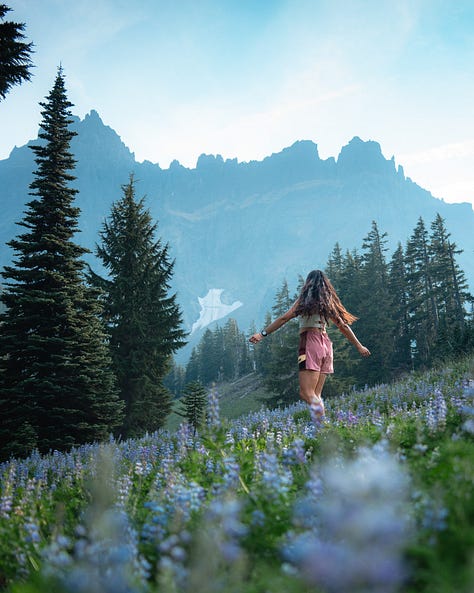
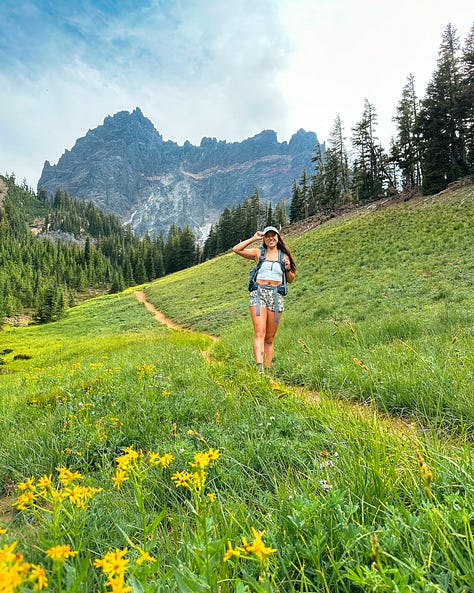
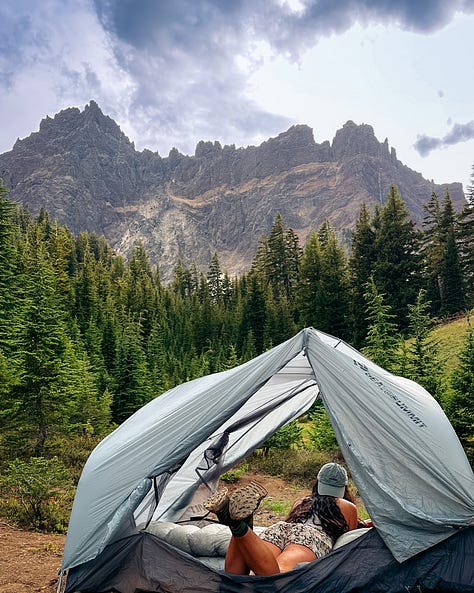
Marion Lake
Mount Jefferson Wilderness | Near Santiam Pass, OR
5 miles RT | 935 ft gain | Out & Back
Central Cascade Permit Required + NW Forest Pass Required
Marion Lake is an excellent entry point into backpacking. A short 2.5-mile hike leads to a beautiful alpine lake with established campsites and swimmable water. You’ll pass through dense forest, climb gradually, and arrive at a wide basin with views of Three Fingered Jack.
It’s an ideal spot for a one-nighter or even a last-minute trip after work.
Best time to go: Late May through September.
Snow tends to melt early here, making it one of the first accessible backpacking spots each season.
Trail tip: If you’re new to backcountry camping, this is a great place to practice setting up camp, filtering water, and sleeping outside, without being too far from the car. Plus you can backpack this in late May before permits start on June 15!
Jefferson Park
Mount Jefferson Wilderness | Near Detroit, OR
11.2 miles RT | 2,320 ft gain | Out & Back
Central Cascade Permit Required + NW Forest Pass Required
This one’s a little longer, but it’s worth every step. Jefferson Park is one of the most iconic backpacking destinations in Oregon, with turquoise lakes, wide meadows, and Mount Jefferson towering above the treeline. The trail in is steep in sections and includes a few creek crossings, so save this one for when you’re ready for a challenge.
Most people camp near Scout Lake, Bays Lake, or Russell Lake. All have stunning sunrise views and clear water for swimming or filtering.
Best time to go: Late July through September.
Snow tends to linger until mid-summer, and the area can be crowded during peak weekends, so aim for a weekday or early fall trip if you can.
Trail tip: Pack warm. The elevation is higher here, and even August nights can get chilly.
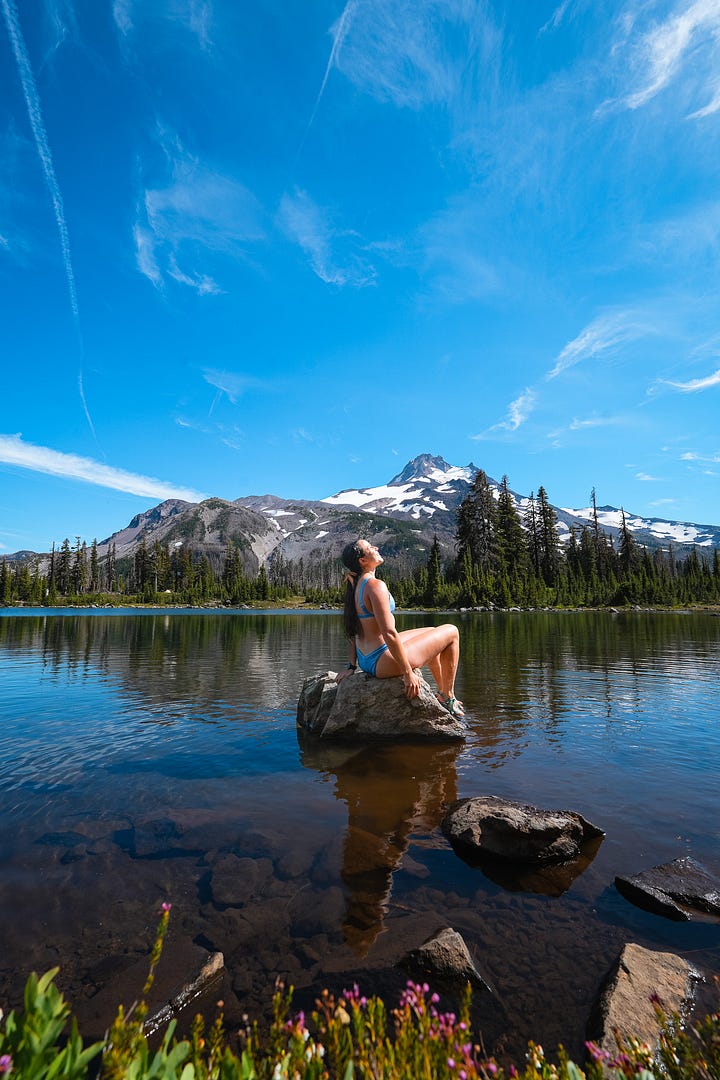


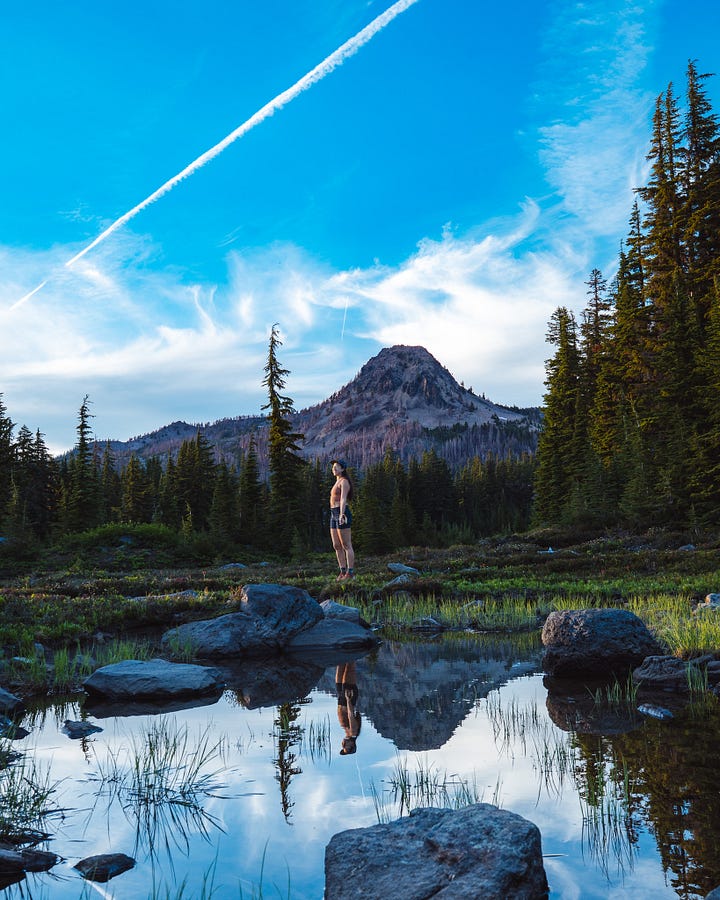
Community Questions
“How do you get started for the first overnight camping trip?”
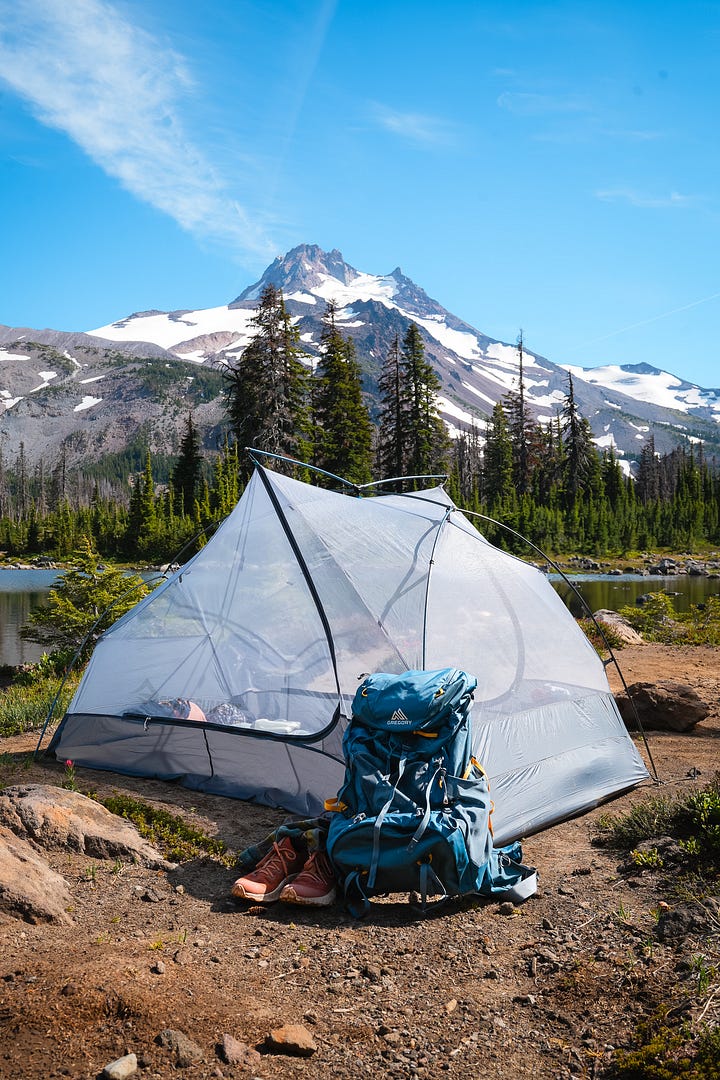

I love this question. Because it can feel really overwhelming at first. Here’s what helped me when I was just starting out:
Start small. Pick a trail that’s 2–5 miles each way, with an obvious campsite and a nearby water source. The goal isn’t to prove anything. It’s just to get outside, set up your gear, sleep under the stars, and see if you vibe with this whole backpacking thing.
Borrow or rent gear if you can. Test out backpacking before you invest in every item. (Some REI stores and local gear shops offer rentals!)
I’m not saying this is the best example, but it’s real:
My first overnight trip was Memorial Day weekend 2019. I bought a sleeping bag from REI Outlet, and Anders and I split a tent from the Memorial Day sale (for $120?!). Sleeping pad? Nope 🤝 I got very familiar with the cold ground. Backpacking backpack? I used my old North Face school backpack. Hiking boots? Still nope. Just my beat-up running shoes. Stove? Lol. I lived off cold bagels, peanut butter, a giant chocolate muffin, and some sad soaked oats.
So safe to say I didn’t “have it all”. But I did find my love for backpacking!
Do a “mock trip.” Take your gear car camping. Test your stove. See how your sleeping pad feels. You can even do pack walks with your full gear around the block. It will make you feel way more confident on the trail.
Go with a friend if possible. It’s so helpful to have someone to troubleshoot with, split gear weight, or just laugh with when your Jetboil tips over 🙃
And most of all: plan ahead. Know your route. Download offline maps (or better yet, bring paper). Check the weather. Don’t forget a headlamp. You can’t overprepare when you’re learning.
TLDR: keep it simple, practice before you go, and remember, it’s normal to feel nervous. This trip won’t be perfect, but every confident backpacker had to start somewhere.
📬 Got a trail, backpacking, or gear question? Drop it in this anonymous survey to be featured in a future newsletter. I love hearing what’s on your mind!
Leaving Notes
If you’re thinking about trying backpacking for the first time, or easing back in after a break, I hope this guide gives you a starting point. You don’t need the fanciest gear or the longest trail to have a meaningful weekend outside. Just a plan, a little preparation, and the willingness to see what happens.
If you have any questions about trails, gear, or backpacking in general, you can always drop them here. I love answering community questions in these newsletters, + you can help guide our topics!
If you’re enjoying Big Adventure Club and want to support me for free, you can:
Like this post or reply and tell me where you’re headed next
Forward this to a friend who’s curious about backpacking
Shop through my REI link. It costs nothing extra and helps me out
Browse my Links Page for favorite gear, style, and trail ideas
Thanks for being here 💙
See you next week,
Lauren (@laurensbigadventure)






